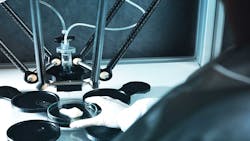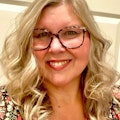3D Bioprinter Is Advancing Personalized Medicine and Tissue Engineering
In a press conference held in Feb. 2025 at 3D Experience World in Houston, Machine Design learned about the Electrospider from Bio3DPrinting. The company was spun off from Italy’s University of Pisa, where Roberto Rizzo, president of Solid World SRL, a distributor of Solidworks and user of 3D Experience, saw the potential in biomedical technology and the possibilities for bioprinting to improve patient outcomes.
Solid World has collaborated with the University of Pisa over the years, which has resulted in several innovative projects. These include the creation of the Electrospider, a 3D bioprinter capable of producing three-dimensional human tissues—reportedly, the first machine able to do so.
When Machine Design asked about the types of 3D printing technology that the Electrospider uses, we learned that its unique multi-tool print head synchronizes several bioprinting methods to create intricate structures with diverse biological materials.
Aurora De Acutis, president of Bio3DPrinting, explained the five different 3D bioprinting technologies:
- Extrusion of hydrogen. This is a method that uses hydrogen for specific applications.
- Extrusion of thermoplastic material. This allows for printing with materials that can be melted and shaped.
- Extrusion of thermal-sensitive materials. This category includes cells and other biological materials that could be printed at controlled temperatures.
- Extrusion of photosensitive materials. These materials can harden when exposed to certain light wavelengths.
- Electro sputter technology. This is a unique feature of the Electrospider that distinguishes it as the first bioprinter capable of combining electro sputter with other established printing technologies.
The ability to print multiple types of cells and materials represents a significant leap forward in bioprinting technology. De Acutis said the size of the printer is comparable to a refrigerator, and that its design was a challenge that was overcome using Solidworks design platform, allowing meticulous design and simulation processes that ensured seamless operation.
She also explained the bioprinter knows what to print using a structured “printer pipeline.” It begins with medical imaging, where specific regions that need regeneration are identified. From there, a cast model is created. This model generates a logical file that can be adjusted to meet the requirements of the bioprinting technology being used. Once the file is ready, it is uploaded into the printer, which then operates autonomously without further intervention, beginning the printing process according to the provided instructions.
Applications for Healthcare
The Electrospider is primarily being utilized in oncology where it can replicate cancer cells for drug testing. This personalization of medicine allows for the customization of treatment to the individual patient’s needs, aiming to significantly improve the efficacy of cancer therapies. The technology also has potential applications in treating genetic diseases, where traditional methods often fall short due to the limited size of the patient population for clinical trials.
De Acutis noted that one of the main hurdles facing the development of complete organs through bioprinting is ensuring proper vascularization, the network of blood vessels needed for tissue survival and function. While the Electrospider can currently print small tissue samples, De Acutis said, ongoing research aims to overcome the technical challenges of scaling up to entire organs, such as hearts or kidneys. The integration of vascularization algorithms into the design process is a key focus for future versions of the machine, Rizzo added.
Regulatory and Ethical Considerations
As bioprinting technology advances, so do the associated regulatory and ethical challenges. Companies and regulators face the complicated task of defining how bioprinted organs and tissues should be classified, whether as living or non-living materials. While some countries have begun allowing clinical trials with bioprinted tissues, much remains to be done globally to establish clear guidelines, according to De Acutis. “It’s not a technology issue,” she said. “It’s more [of an] ethical and legal [issue].”
About the Author
Sharon Spielman
Technical Editor, Machine Design
As Machine Design’s technical editor, Sharon Spielman produces content for the brand’s focus audience—design and multidisciplinary engineers. Her beat includes 3D printing/CAD; mechanical and motion systems, with an emphasis on pneumatics and linear motion; automation; robotics; and CNC machining.
Spielman has more than three decades of experience as a writer and editor for a range of B2B brands, including those that cover machine design; electrical design and manufacturing; interconnection technology; food and beverage manufacturing; process heating and cooling; finishing; and package converting.
Email: [email protected]
LinkedIn: @sharonspielman
Facebook: Machine Design
YouTube: @MachineDesign-EBM



